Evil hair.
I'd like to talk about exactly why hair is such a staple in Japanese horror movies, stories, games, everything really, and to be honest, it deserves its own entry to shine as the paradigms of great traditional horror that it is. Let's take a look on why the subject of "hair" is so important in Japanese folklore, culture and horror, as well as some excellent usage of it in modern-day media.
You read that right, I'm going to be talking about really good, actually scary traditional Japanese horror!
Hair is one of the most basic and recognizable elements of traditional Japanese horror. But the reason that a woman's long black hair has become so ingrained into folktales and scary stories that it has become frightening on its own dates back a long, long time, so that we must understand how it came to be before we figure out why.
Japanese women are absolutely insane about their hair. Obsessive and meticulous to the point of madness. It all started, where else, but in the Heian period, where all idle hobbies attributed to the noble people of the court bred into deranged fetishes and ran rampant. In almost every society, a lady's hair was a symbol of her beauty, and had been thought of this way long before the Heian period rolled around, but the Heian cult of beauty descended on it as it did everything else and it became like a matter of life or death for the court ladies.
The Heian period lasted from 794 to 1185, and is considered "ancient Japan". When one thinks of ancient society, or what other places were doing around this time, thoughts of cavemen or serfs farming mud and shunning education come to mind. The Heian capital of Japan (Heian-kyo, now Kyoto) was heavily influenced by Chang'an, the capital of China at the time. Naturally, China is well-known for the stunning advancements their civilisation made hundreds and thousands of years BC, and by the Tang Dynasty, they had reached a state of excess; the nobles got the very best of the best, and everybody was concerned only with society and culture and having fun, and Japan fully embraced this lifestyle, modeling the city after the layout of Chang'an, and throwing themselves headfirst into hedonism. Both women and men were caught up in appearances, and beauty in all forms were worshiped with a passion.
Many people believe that Japanese women are very demure and repressed, but the Heian period especially proves this to be untrue. While the medieval knights were trading women as lesser than cattle and making life hard for the farm girls, the Heian women were free to mouth off to whomever they pleased, spend their time doing nothing, or, if they chose, developing any fetish they felt like, and encouraged to read and write. The men obviously got the best education, consisting of learning fashionable and trendy Chinese, but women were free to learn to write in Japanese, so that they could compose poems or letters to one another. Almost every bit of information on the Heian period is gleaned from the writings of a woman at this time.
Unfortunately, since the women were so preoccupied with any random thing that caught their fancy, some of the most basic information on daily life in the Heian period is lost, since they found it too mundane to write about. Very little is known about how Heian women actually looked, since it was to be assumed that any court woman was automatically beautiful in some way. In fact, since the women spent most of their lives alone, and were so rarely seen since they didn't like to travel outside at all, the only thing worth noting was how fashionably they were dressed or how lovely their hair was. Their real merit of attractiveness was found in their hobbies, be it their ability of conversation, the neatness of their handwriting, the poetic commentary of their judgmental eye when viewing fine artwork, the practice and extravagance of folding a letter, or any random thing.
In the most famous account of the Heian period, as well as being the first modern novel, Genji Monogatari was the tale of a young man and his romantic exploits in and around the capital of aristocracy. It was written by a woman, Murasaki Shikibu, and while so much of the novel focuses on the many loves and conquests of our protagonist Genji, she would often remark about how Genji or another notable gentleman would be left speechless, his breath taken away at the sheer beauty and the sight of a woman, but she rarely made any comment on their actual appearance at all. Another famous book written at this time, by another woman called Sei Shonagon, is called "Pillow Book", basically a diary of her thoughts and observances of daily life. She too only cared to mention another lady's good looks in regards to the woman's hair. She, Murasaki Shikibu, and all other Heian women found it indecent to talk about the body, especially the body of another person, and even more especially someone of your own gender. All women copied their look after the lovely ladies of Chang'an, but were supposed to just follow the trends and all generally appear interchangeable, as no actual portrait of any woman from this time is known to exist. So there are no exact records of what any beautiful Heian woman looked like, or what made her so different from any of the other women, all except in the cases of the beauty of their hair. These descriptions were lavished with loving detail.
The Heian women were completely mad over their hair. It is mentioned that the bathing ritual and special care-taking of hair could last for up to twenty hours. Often, women would spend an entire afternoon relaxing by having someone brush or touch their hair, which, depending on the person touching the hair, could and did develop into sexual foreplay. One could not mention a woman without saying a few words about the state of exquisiteness of her hair. They all wore it parted down the middle, and it was most desirable if it was thick, shiny, and especially long. Senselessly long. Ideally it should touch the ground. At one point, Murasaki Shikibu jealously mentions that a friend of hers has hair several inches longer than her height. One character in Genji Monogatari had hair that was over six feet long. Another character who was extremely popular with men experiences the intense infatuation of a man who just saw her for a brief moment, catching a glimpse of only her hair as she walked away. That was enough for him to fall desperately in love.
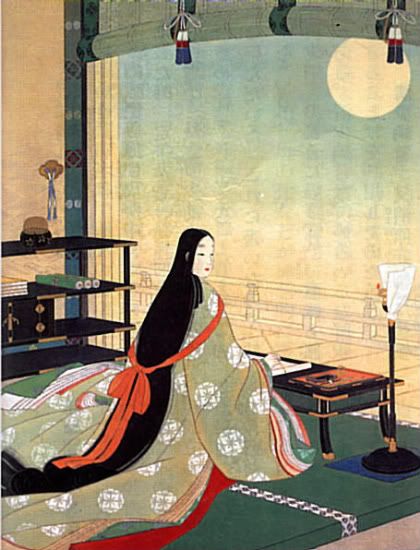
Sometimes women would choose to devote themselves to religious practice, and a necessity for this was the ritual of cutting off a great deal of one's hair. This symbolised the devotion they had for their new role as a priestess/nun/etc., and provided a metaphor for marriage and complete devotion to their new lives. Onlookers during the tonsure would sob aloud at the sight of it, mourning for the loss of such lovely hair that would never be able to grow to its fullest length.
So yes, it was the Heian period that nurtured the seeds of flagrant obsession about hair in Japan.
During the Edo period (1603-1868), the majority of the Heian insanity had been quelled by the Sengoku era, AKA the Warring States Period, where everybody was in battle to rule the land and hopefully have peace. When the Edo period established stability and began modernizing the country, Tokugawa Ieyasu, the first shogun and the man responsible for uniting the country, went around restoring order to the people. This included, among many other things, choosing a universal manner of dress, clothing, and ways to wear one's hair. The kimono as we see it today, where it is seen as the traditional clothing of Japan, was a brand-new trend at the time, with the cut and sleeves/obi style being declared the thing to be worn by any respectable woman. The traditional ladies' hairstyle, the shimada, was a type of high puffy bun, commonly associated with geisha in the modern era.

Like geisha, the ladies at the time all had a particular way of wearing it which would signify anything and everything from their mood, an occasion, the season, or their marital status. Many styles were outrageously complicated, and women were extremely competitive about the type of kanzashi (hair ornaments) they wore. Men would give kanzashi as favours, gifts, signs of affection or even bribery. Ladies would jealously compare and fight for the most desirable kanzashi to show off their status and favour with men. Alternatively, if a man did not care about a woman, say, his wife or the geisha he was patronizing, she could insult him just by switching her hairstyle. For example, she might wear it as if she were unmarried though she has a husband, or she might purposefully make it look bad, therefore making her lover lose face since everyone would know that he didn't care about her enough to make sure she left the house looking presentable.
Despite the new penchant for wearing the hair up and covered in a vast array of ornaments, it was still kept long and attended to with much of the same adoration as it had been since the Heian period some thousand years earlier. Still present was the taking of specialized baths, which included carefully perfuming and caring for the hair, but with the recent popularity of the bathhouse, women would flock to them to wash and show off their hair. Because of this, almost all bathhouses quickly instated a special tax or extra cost for a woman to use the facilities because of the sheer amount of excess time and water that they would use.
Many popular horror stories originate from these periods of history. So it's only natural to assume that, since a woman's hair played such a significant role in her daily life, as well as the lives of the men who looked at her, such a thing could easily become a fixture in a horror story.
At its most basic, long hair is simply viewed as beautiful and feminine. It's ingrained in the genetic makeup of men to be attracted to femininity, and the ultimate expression of femininity in general appearance is a person with very long, flowing hair. This is why so many characters in anime and manga have the crazily long hair that moves like no hair should and gets everywhere. Long hair instantly arouses interest by seeming feminine, and can make the girl appear either very sexy, or very innocent. That's another reason why so many Japanese horror stories center around women with long hair. Emotionally, we want to believe that things supposed to be weak, innocent, pure or lovely are just that way and nothing else. It's why there are so many demon women and evil foxes in disguise; why little children are secretly yōkai; why someone you care about may be something bad and you don't even know it. It's the surprise of the unexpected.
The vast amount of ghost stories, and Japanese horror stories in general, came from the Edo period. With the war over, and nothing particularly disturbing to fuss over, the simple people of the Edo period focused their attentions on being afraid of their now fast-changing lifestyles. Western influence was the fear of the unknown, and the new capital in Edo, now Tokyo, instead of the familiar Kyoto, made everyone feel nervous and out of place. These fears were played upon among idle gossipers and party-goers of the time. 100 Ghost Story Night (Hyakumonogatari Kaidankai) became a popular pastime. People would gather for a banquet and, as the party wound down, one hundred candles would be set out and lit. As it began to get dark, the guests would gather in the room and take turns telling a scary story they had heard, or claim to know someone who knew someone who experienced it. After each ghostly tale, one of the candles would be blown out, until the room got extremely dark, and there were only a few candles left. The last few stories would have been saved as the best and most frightening, and the game went so that, as the last candle went out, a demon would be summoned and appear in the room. Various stories exist from people who claim to have "seen" things at these events, and those stories too would be added to the next game.
Many supernatural creatures were "invented" during these games, and that is why there are so many different types of yōkai, ghosts, demons and monsters with varying appearances and habits. These became very trendy, which is why the obake karuta deck remains so popular and coveted. Even when it was new, the deck was often traded and collected by people of all ages. I'll mention two popular yōkai that focus directly with women's hair.
First up is the most feared of yōkai, the Kamikiri (髪切り, literally meaning "the hair cutter"). My mother, who studies horrific things for a living, which involves going to haunted places and interviewing people who have had terrible experiences with the supernatural, has become accustomed the the scary sights and is more fascinated with them than anything. But the Kamikiri strikes a deep and inescapable fear into her heart, as it did back in the Edo period when rumours of it, and likely even actual Kamikiri, ran rampant.
It has been described in a number of ways, but a most popular version envisions it with the head of a crow or insect, complete with pincers in the mouth and on the hands.
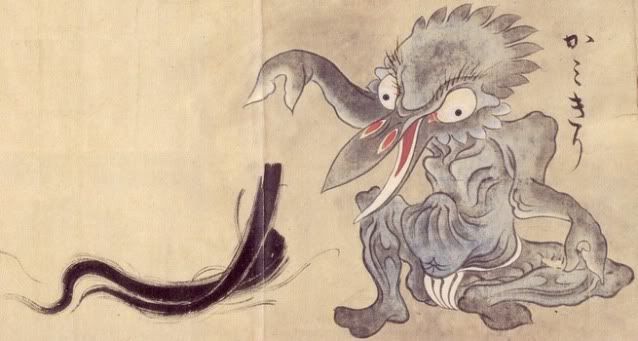
This illustration comes from Sawaki Suushi's Edo-period work, Hyakki-Zukan, "Illustrated Volume of of 100 Demons". Almost every work about supernatural creatures by artists at this time, including greats like Toriyama Sekien and Tsukioka Yoshitoshi, would be compiled over a work or several works with 100 pieces each. This was to immediately bring to mind the 100 Ghost Story Night and therefore be sought after.
Another type resembles a large bear covered in thick dark fur, also known as Kurokamikiri, (黒髪切り), which means "black hair cutter", which is, surprise surprise, a pun not only for his look, but to further incite terror into young ladies who live with a constant nervousness that their long black hair will be lopped off against their will.
Compiled after the fact, the story goes that the Kamikiri will sneakily cut off the hair of a young woman who is unknowingly engaged to marry a yōkai in disguise. This hearkens back to the cutting of hair during a tonsure, signifying marriage to religion, to keep her safe from the monster she is involved with, and to prevent the wedding from taking place. Most likely, however, the story originated because it was a very easy way to strike terror into naïve young women who would rather die than have their hair cut off, and would therefore make for the best story of the evening when all the ladies would get riled up and start holding onto their heads and looking suspiciously at their husbands. Such urban-legend style stories remain, most of them involving a woman walking home from somewhere, and as she arrived, being informed that her hair has been cut off. The woman then will let out a bloodcurdling scream and/or pass out from the shock, and her family will retrace her steps to find her hair laying in the path she took, cut off cleanly. Since the Kamikiri is so secretive, the hair is easily snipped away without the woman even realising it, so that there is no way for her to defend herself or her precious locks from the beast.
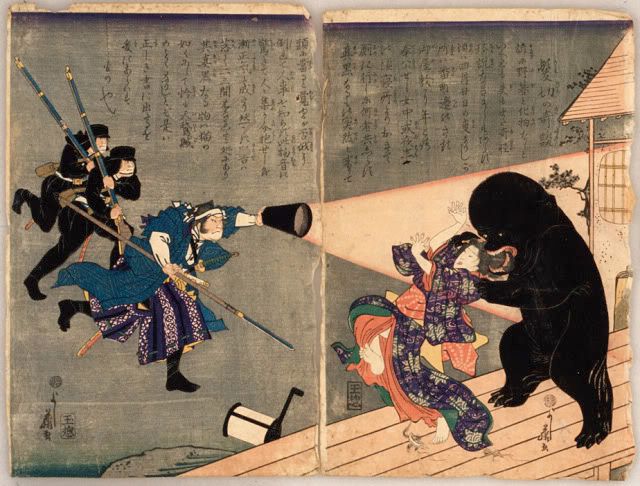
Obviously, this was a grave anxiety among the ladies of the Edo period.
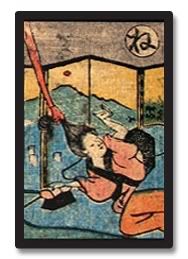
This is the Kamikiri karuta.
But it's not just women who have cause to be terrified over their hair. Recalling that long hair is so attractive to men, and that the woman who possesses it is seen as an ideal and beautiful wife and someone to be cared for, one of the many demon ladies that would make your life miserable without you even being aware until it is far too late, preyed directly on the obsession with long hair that men wanted and women must always care for.
She is known as the Harionago (針 女子, "needle woman"). Though she, like many other demon ladies of her ilk, appears to be a harmless woman, or at least just a normal human, she is actually a monster in disguise. Whether she is actually a type of yōkai, or the ever-popular scorned woman who has become so vengeful that she has developed demonic qualities or appearance remains to be seen, but the manner of her interest certainly suggests the latter. She seems to be a beautiful young woman with very long, attractive hair, she will walk up and down the roads looking for men to torture. If she encounters a man, she will let out a manic laugh (another aspect of female yōkai tailored to terrify men, since women should be non-murderous, and laughing should be a happy thing), and if the man laughs back, her hair will suddenly spring to life and ensnare him, circling around him like a spider wraps up its prey, or else striking at and attacking him with the sharp, needle-like barbs on the tips of their hair. The only way to escape this fate is by running away and locking yourself firmly in your house. Some stories say, however, that the Harionago will follow and wait outside until morning, able to capture you should you leave again in the night, but after the morning comes, you will find hair wrapped around the entrance and many angry striations in the door from where the hair was attempting to get in.
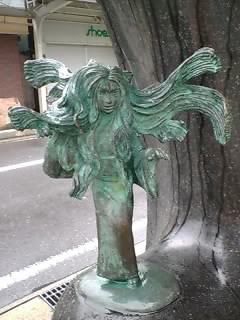
A Harionago on the Mizuki Road.
The Harionago, besides having thorny points on the ends of her hair, differs from a normal woman as well in the fact that the hair itself is not a monster, but in fact completely prehensile and under her direct manipulation. This does, however, suggest that it is possible for a woman, spiny hair or no, to develop the ability to control her own hair, making the Harionago a type of monster that someone could become, instead of simply a naturally-occurring yōkai.
The idea of a beautiful woman with long, deadly hair certainly is a captivating image dating back quite a ways. It also remains a popular motif to this day, easily updated and able to appeal to audiences in many modern Japanese movies, anime, and manga. Featuring a Harionago-type girl (and might I mention Yashamaru of the Kouga Ninja Scrolls series, who uses as his ninja method of attack specialised strands of womens' hair that he himself learned to manipulate) who, for whatever reason, have the ability to control the movements of their hair and, more often than not, use it to fight people. Did I also say that it makes for a great video game character?
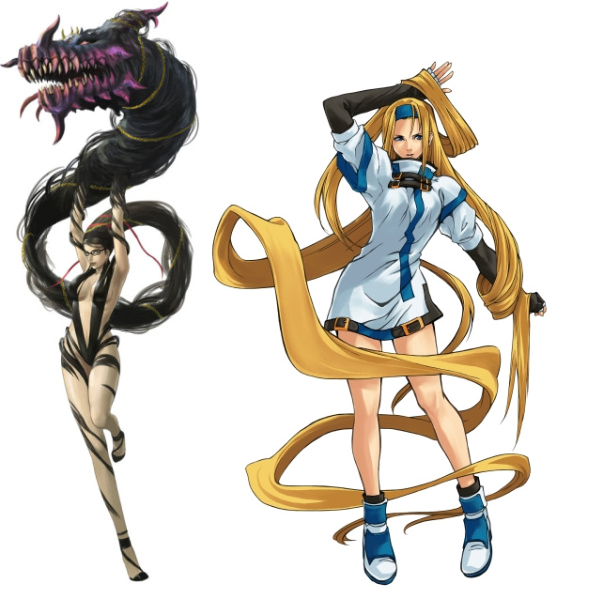
Because it does.
But yōkai aren't the only thing from this time period that enjoyed a sudden surge in popularity once again in the modern era. Novels rich with elements of horror and the supernatural became so popular that, even after the era had passed, the works themselves are still considered to be outstanding examples of literature to this day, not merely a folktale fad. Many of the themes and psychological horror are universal; it is the same basic structure of a Japanese ghost story and the same ideas and imagery that frightens the Japanese psyche, legends that have been told and re-told and updated and relocated and remain a part of the collective conscience, like a superstition or a fairy tale.
In the 1950s, known as the "golden age" of Japanese film, many famous folktales were presented for the very first time in movie form. People now flocked to films, no longer to be amazed by the motion picture, but as a form of escapism. They wanted to see the new brilliant color pictures, and Hollywood and other foreign films provided glimpses into places never seen before. The Heian and Edo period too were something never seen before, now portrayed to the audiences for the first time amidst easy-to-relate-to stories of love, honour, war, peace, betrayal and, of course, ghosts and monsters and the supernatural. The familiarity with the human elements, or even the original tales were now seen as brand-new to movie-goers.
I've mentioned Lafcadio Hearn before, a foreign writer of the Meiji period who later became a naturalised citizen of Japan, and, with the help of his wife, wrote many books on the country and its traditions, ideals, customs, and, most famously, ghosts and folk legends. Previously unknown to the rest of the world, the books became very popular for English-speakers who wanted to learn about the subjects. Ironically, they also were translated into Japanese, and became popular in Japan as well, since many of the tales were only passed on orally, and people in other areas of the country had never heard them before, or wanted to preserve them. A film, Kwaidan, named after his most popular work, re-imagined a few of the tales he had recorded, and was released in 1964.
The very first story, taken from "The Reconciliation", is re-titled "Black Hair", and focuses, appropriately enough, on a man who leaves his faithful wife in order to marry a higher-ranking woman, thus obtaining a higher rank for himself. The marriage turns sour, and his new wife casts him out and into the streets. With nowhere else to go, the man returns to the home of his first wife, who has been dutifully waiting for him all this time. They spend a night of bliss together, and he reminisces on their happy life and how, during his entire time away, he could think of nothing but her beautifully perfumed, shining, long black hair.
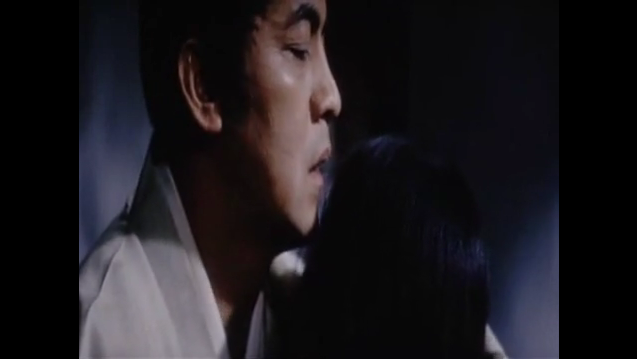
It turns out she's been dead and, as he wakes up, it was all an illusion. Laying in the now-dilapidated house is just a skeleton draped in very long hair.
Even when tales of the supernatural do not focus on, or have anything to do with hair at all, the image of a woman with hair like that does a good job of characterization on its own, setting the stage for scary things to come.
In 1776, Ueda Akinari published the work Ugetsu Monogatari, a collection of short stories based off of many popular ghost stories from China, which he had subsequently spent many years of his life adapting into a Japanese setting, researching the writing of Japan's past and painstakingly recreating the works in the method of the period the stories would have taken place in, focusing not on the supernatural elements, but the human emotions of the characters and the supernatural occurrences as well, resulting in a masterpiece of metaphor, prose and, of course, lots of involved puns. Heaping praise on the new standard of living brought on by the Tokugawa regime, "commoners", members of the merchant class or non-aristocrats were now afforded a much higher education, as Ueda himself received and taught, his works and thoughts reflecting heavily on his mission to write in a high-class way like the popular novels of the Heian court, and allude to so many of the famous works previously reserved for the wealthy alone, so that he and all of the readers could take pride and get something extra out of being able to identify them.
Despite the origins of the tales in the realms of the strange and occasionally demonic, the enduring quality remains in the choice to focus the stories solely around members of the commoner class, like those who were now living in the capital and wanted to read an anthology of supernatural stories. The care he put into fleshing out the characters' personalities (something that had not been done in any of the works he had selected to adapt) and the artful way in which he included references to the elite works of China, aristocratic Japan, and even Noh theatre, makes it an outstanding example of literature, not to mention one that also features horror elements.
The dreamlike quality of the book was later recreated very faithfully by acclaimed director Mizoguchi Kenji, in the film of the same name, based loosely off of two of Ueda's stories.
Here, the phantom lady watches as her lover sleeps, before taking a brief moment to sit at her mirror stand and think to herself as she brushes her hair.

He stirs in the other room.
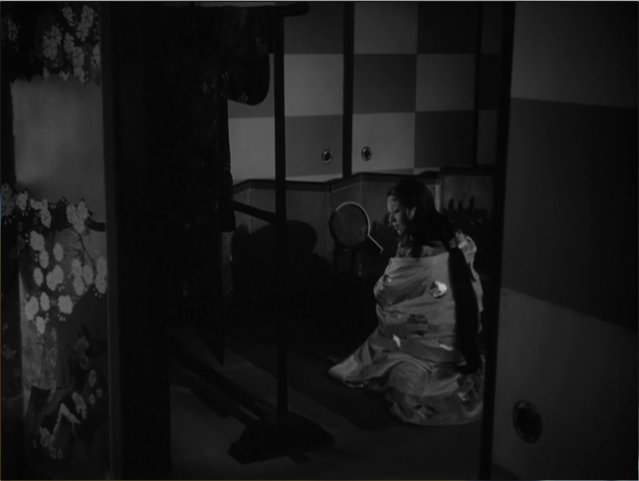
This simple moment took no less than thirty seconds, but the film immediately begins instilling a sense of foreboding, and something seems to be not quite right with the woman simply by the way in which she paused to look at her hair.
It is just as true today as it was one thousand years ago: A Japanese woman with extremely long hair has spent a lot of time caring for it, time that was also spent developing a very deep and irrational hatred for something that you personally hold dear. The concept requires little to no modernization.
A setting far away from the Heian capital in time, place and media itself is the game series Fatal Frame. A tour-de-force of the most disturbing of Japanese horror, old and new, a hair-obsessed woman makes her way into the game as well.
In Fatal Frame III, a woman with extremely long hair takes a lover, who manages to give her a halfhearted compliment on its beauty as he leaves her the next morning. Unstable and quickly becoming insane, she is convinced that he will return for her and spends all of her time sitting in front of her mirror stand waiting for him. All day she brushes and cares for it, and talks to herself about how he told her that it was beautiful. Eventually she begins pulling chunks of it out and nailing them to the wall to show it off, should he come back for her and look for her by her mirror stand if she was not there.

That. Right there. Take note, here is something that absolutely terrifies me.
But not everything can be a paradigm of the deep and varying examples of Japanese horror, and any good story can and will be modified to suit the audiences of the day. Film is a very tricky medium to modernize horror into, however, since the story, well-known or not, must be reinstated again, then adapted into the modern-day period, and only so much time is available with which to do so.
Modernizing a story about yōkai or frightening occurrences into the contemporary can definitely present a challenge. It is simple enough to just bring a yōkai back and make it a creature feature, but for those who wish to re-imagine classic horror in the very slow, suspense-building storytelling of a Japanese folktale while presenting it to a modern audience or even into a modern time will usually either be very very innovative or very very nonsensical and misled.
To modernize a work, first one must look at the modernization of the people themselves. What has changed from the time of the story to the time of the retelling? At the turn of the century, Japan turned to Western influence in hopes of becoming more involved with the world powers. Many people were opposed to such a thing, fearing industrialization, loss of culture, and all the strange new things happening around the country. The common Japanese were faced with the choice of embracing Western culture and the new technology of the moment, or staying true to their traditional life and beliefs. Those who had known nothing else looked down on the youths who flocked to Hollywood trends and Western dance-halls, just as the parents of the flappers were doing in America as well.
Now, however, Western customs interact constantly with Japanese ones, and a careful balance between youth culture and traditional values is walked on a daily basis. This provides the groundwork for the exact opposite circumstances to take place: a modern-day youth following the fads of traditional Japan.
In the 1920s, it was popular for a girl to cut her hair into a "bob" style, a very short look, radically different from the worldwide ideal of long hair up to that point. Presently, for a woman to choose not to cut her hair, to embrace the traditional love affair with disturbingly long and obsessed-over hair, is viewed just as strangely as were the young women lopping it all off a century ago.
Modern girls who choose to live a life worshiping at the Heian-jidai cult of beauty are just as abnormal and rather supernatural as a ghost or a yōkai, and easy enough to portray as such in horror. You may want to believe that this woman has traditional values, or is a priestess, but instead, it can be seen that she is the manifestation of an actual ghost or demon from that time period. Since yōkai fall in and out of popular culture, it isn't that they are extinct or disappearing, it is that they flee to places to hide, away from the new structures being built over their habitats, or the modern people who no longer understand or fear them. Angry at this turn of events, they will, just as they did during the Edo Capital construction, lie in wait until the humans get comfortable, study them, and integrate themselves slowly into the new society in order to adapt and continue their reigns of terror or trickery. So, as the kitsune disguised itself as a stunning courtesan, a supernatural being today could conceivably masquerade as a traditional woman in an attempt to do the same thing. It's easily adaptable to modern sentiments.
I have, in my circle of friends, not one but two girls who maintain the lifestyle, content to dress almost solely in kimono, accompanied by the scary long hair and pale, eyebrowless face. It is almost like constantly being a part of a horror movie when around them, as they are both rather eccentric and devoted to their way of living, not to mention their hair. Open-heart surgeons use less care and fewer implements than my friends do when styling their hair. One of them actually becomes enraged if anyone even slightly touches it, thinking that it will be mussed and ruined, and even goes so far as to attack her own boyfriend if he so much as runs a finger through it.

Yeah, something like that.
The Ring series is generally credited with heralding in the trend of traditional Japanese ghost stories, while also updating it to appeal to a modern audience in a modern setting, and I have to agree. Even the idea of being freaked out by hair comes into play once again, as, like in Ugetsu, we have a very brief, but very unsettling moment featuring a woman quietly brushing her hair before a mirror.

She senses someone behind her.
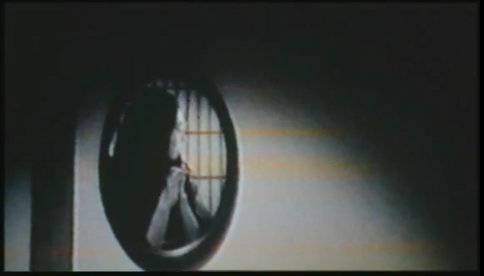
Even Sadako's hair plays a role, winding around everything and floating eerily in the water, and serving to obscure her face, though that applies to another yōkai which is frightening in a different way.
So there you have it, an entry as long, dark and confusing as a Heian woman's hair.
No comments:
Post a Comment